
The iconic preparation for turkeys entails golden roasting them. But roasted birds easily become over-cooked and dry, and using up a whole turkey can be challenging in smaller households. Preparing a full turkey or turkey parts on the stovetop often presents a more practical option, and you have several possible approaches. The end result won't be as picture-pretty, but it's often tastier.
Braise the Bird
Video of the Day
Step 1
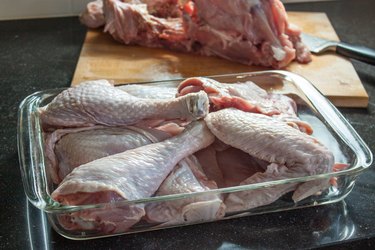
Cut up your turkey into 10 to 12 pieces, as you would with a chicken you intended to fry. Cut the breasts away from the ribs and keel bone, and set aside the keel bone, backbone, tail and wingtips.
Step 2
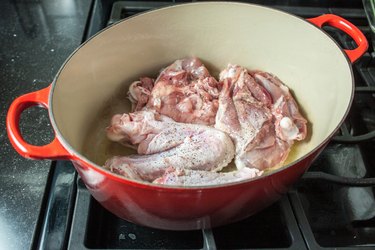
Heat a tablespoon of two of oil in the bottom of a large Dutch oven or heavy-duty roasting pan. Brown your turkey pieces in the pan a few at a time, without crowding, starting with the fattier wings and thighs and finishing with the breasts. Enough fat will render from the dark meat to prevent the white meat from sticking.
Step 3
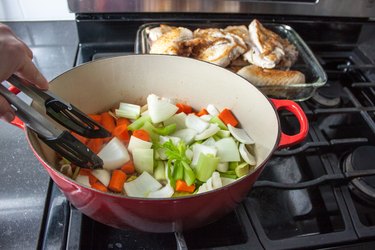
Refrigerate the breasts but keep the rest of the bird close at hand. Pour off most of the fat, reserving some in the pan. Coarsely chop 2 parts onion and 1 part each of celery and carrots, and toss them into the hot fat. Stir them frequently until the mixture gives off an aroma and the onions begin to brown.
Step 4

Arrange the drumsticks and thighs at the bottom of your pan, with the wings resting on top. Add enough chicken, turkey or vegetable broth to cover the dark meat, then any additional aromatics such as garlic, rosemary or spices.
Step 5
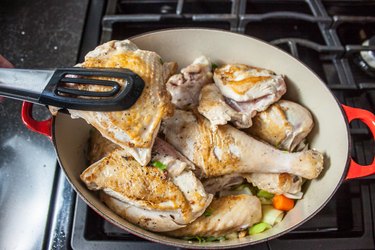
Bring the liquid to a gentle simmer, then cover the pot and cook the dark meat gently for approximately an hour. The legs' connective tissues will begin to melt during this stage, giving the dark meat a lush, soft texture. At the one-hour mark, open the pot and nestle the quick-cooking breasts on top of the other pieces of turkey.
Step 6
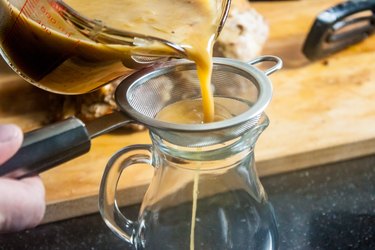
Simmer for another 20 to 30 minutes, until the breast reaches an internal temperature of 165 degrees Fahrenheit when tested with an instant-read thermometer. Remove the turkey pieces to a serving tray and strain the cooking broth. Skim off any fat, and thicken the broth to make a sauce or gravy to accompany your turkey.
Steam-Roasted Turkey
Step 1

Cut up your turkey into 10 to 12 pieces, or ask your butcher to do it for you. Season the turkey pieces with salt and pepper, and then brown them in a tablespoon or two of hot oil, in the bottom of a large, heavy-bottomed pot or Dutch oven.
Step 2
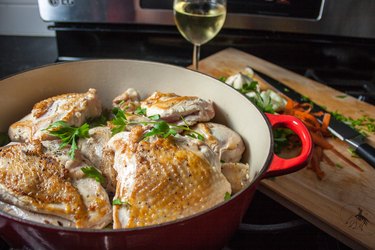
Remove the turkey pieces from your pan as they brown, then add coarsely chopped onions, carrots and celery. Brown the aromatics lightly, then arrange your turkey parts on top of the vegetables with the dark meat at the bottom and breasts at the top. Add garlic, fresh herbs, citrus zest or other aromatics, if you wish.
Step 3
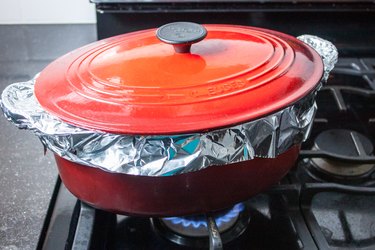
Add 2 to 4 tablespoons of broth, water or wine, and cover the pot tightly. If its lid is not airtight, cover the pot first with heavy-duty foil and then place the lid on top. Alternatively, dampen a clean kitchen towel and use it to circle the edge of the pot, where it will block the steam and help prevent it from escaping. Fold up the towel edges away from any gas flame.
Step 4
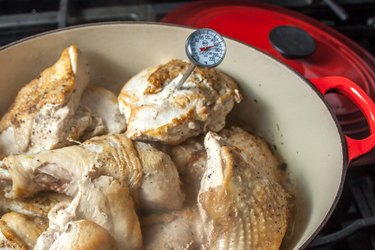
Turn the pot down to a low simmer and cook for about an hour in the tightly sealed pot. The moist air inside your pot cooks much more efficiently than the dry air of an oven, and this should be long enough for your bird to be fully cooked. The breast should show an internal temperature of 165 F, and the thigh should read 170 F or higher, when tested with an instant-read thermometer.
Step 5
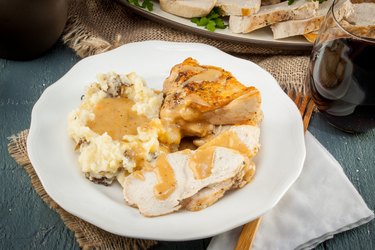
Remove the turkey pieces from your Dutch oven with tongs or a slotted spoon, then strain the intensely flavored cooking juices from the bird and skim off any fat. Thicken the juices to make sauce, supplementing them with additional turkey or chicken broth if desired. Slice the turkey meat, and serve it with the gravy and your favorite side dishes.
Pressure-Cook Your Turkey
Step 1
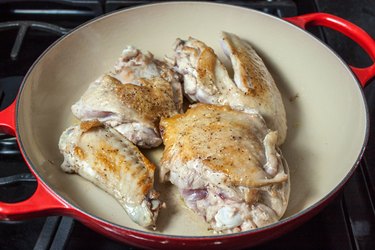
.Cut up your turkey into 10 or 12 large pieces, or ask the butcher at your favorite store to do it for you. Season the pieces with salt and pepper, then brown them in a heavy skillet. This step is optional, but makes for a tastier bird.
Step 2

Place the rack in your pressure cooker, and add 2 cups of water to the bottom of your pot. Layer your pieces of turkey into the pot, filling it no more than 2/3 full. If the whole turkey won't fit neatly into your pressure cooker, reserve the remainder for another meal.
Step 3
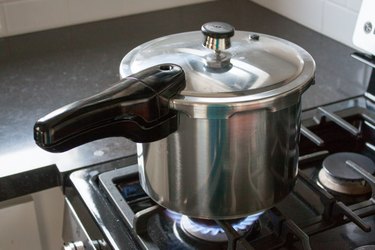
Inspect the lid of your pressure cooker to ensure that the seal is intact, the vents are free of debris and the valves move freely. Lock the lid onto your cooker, with its vent open, and bring the pot to a boil. When steam escapes from the vent in a steady plume, close the vent and bring your cooker up to its full operating pressure of 15 psi. Once it reaches pressure, begin timing.
Step 4

Cook your turkey under pressure for 40 minutes, then remove your cooker from the heat. Let the pot cool on a trivet, or an unused portion of your stove, until pressure subsides. On cookers with a pop-up pressure indicator, the pop-up will drop, and on gauge-type cookers the gauge will return to zero.
Step 5

Unlock and remove the cooker's lid and lift out the pieces of turkey. Slice and portion the white and dark meat, or serve them together on a platter.
Tip
For any stovetop method, smaller turkeys of 10 to 12 pounds work best. Larger birds can also be cooked on the stovetop, but they'll usually need multiple pots or unusually large pots.
Place the backbone, wingtips, neck and other castoff pieces in the bottom of your pot, to add extra flavor to the cooking juices. Alternatively, reserve them and make broth for soups or gravy for other meals.
A splash of white or red wine, cider, apple juice or other liquid can add an intriguingly different flavor to both your turkey and its sauce.
Position the breasts with their browned skin above the cooking liquid, so the skin retains its texture. If you wish, you can re-crisp the skin by placing the breasts in a 450 F oven or toaster oven for a few minutes before serving.
Depending on the size of your pressure cooker, you might wish to chop the bony ends from the turkey's drumsticks with a heavy knife. This makes the leg more compact, and frees space inside the pot.
The pressure-cooker method is similar to steam-roasting in a conventional pot but is more intense. Pressure-cookers create an airtight seal, and as the water in your pot boils it expands to create steam. This built-up pressure prevents the water from boiling at its usual 212 degrees Fahrenheit, instead raising its temperature to 240 F. Ordinary pots can't create that kind of pressure, which is why pressure-cooking is significantly faster.
For another alternative stovetop preparation, you can cut boneless turkey breast and thigh into serving-sized pieces, then prepare them according to your favorite fried-chicken recipe.
Check out this related video from ExpertVillage on Youtube
- U.S. Department of Agriculture Food Safety and Inspection Service: Turkey -- Alternative Routes To the Table
- Serious Eats: Wine-Braised Turkey Legs
- The New York Times: A Great Turkey, Piece by Piece
- The New York Times: Can I Make Turkey On the Stovetop?
- Miss Vickie's Pressure Cooker Recipes: How It Works
- Miss Vickie's Pressure Cooker Recipes: The Pressure Cooker Meat, Poultry And Egg Timing Charts